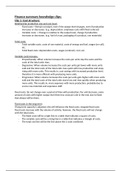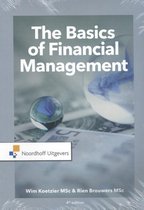Finance summary knowledge clips:
Clip 1: Cost structure:
Relationship production size and cost level:
- Fixed costs-> Remain constant, even if the output level changes, even if production
increases or decreases. (e.g. depreciation, employee costs with fixed contract)
- Variable costs -> Change in relation to the output level, change if production
increases or decreases. (e.g. fuel of a taxi, packaging of a product, raw materials)
Total costs:
- Total variable costs: costs of raw material, costs of energy and fuel, wages (on-call),
etc.
- Total fixed costs: depreciation costs, wages (contract), rent, etc.
Variable costs increase:
- Proportionally: When volume increases the costs per units stay the same and the
costs of the total units rises.
- Degressive: When volume increases the costs per units get lower with more units
sold and the total costs of the total units rises quick with low production and stops
rising with more units. This results in, cost savings with increased production level,
therefore it is more efficient with producing more units.
- Progressive: When volume increases the costs per units gets higher with more units
sold and the total costs of the total units starts low and rises quickly when producing
more units. This results in, more expenses with more production, probably due to
scarce raw materials and expensive staff.
Fixed costs: Do not change over a period of time with production. Per unit decrease, same
amount of costs with higher output level then less costs per unit in the end, due to fixed
that always will be there.
Fixed costs in the long term:
If long term capacity is adjusted, this will influence the fixed costs: stepped fixed costs
Fixed costs increase with the volume of activity; however, the fixed costs will not change
with the total costs,
- The fixed costs will be a right line in a table that indicates a square of costs.
- The variable costs will be a rising line in a table that indicates a triangle of costs.
- The total cost line will be the line above the 2 costs combined.
,Clip 2: Break-even point:
- The BEP refers to revenues needed to cover the company’s total amount of fixed and
variable costs (the total costs).
- At what sales level does a company need to cover all their costs.
- At BEP there is neither profit nor loss, the activity ‘breaks even’.
- The BE analysis is based on assumptions which may not always hold:
Linearity of costs/revenues -> no changes take place in production, etc.
One type of product is only produced.
Production=sales.
BEP is amount of sales where:
- Total revenue= total costs
- Total revenue= total variable costs + total fixed costs
- BEP x selling price= variable costs x BEP + fixed costs -> BEP= amount of units
- BEP x (selling price – variable costs) = fixed costs
- Contribution margin= selling price- variable costs
Break-even quantity (BEP)= fixed costs / selling price – variable costs
Break-even chart:
- Where the lines of revenue and total costs cross, is the break-even point.
- The section beneath the BEP between the revenue and cost line is a loss when the
production is underneath the BEP production.
- The section above the BEP between the revenue and cost line is a profit when the
production is above the BEP production.
Safety margin: Higher the margin -> the less risk
- Is the gap between the break-even quantity and the actual sales.
- Indicates the risk of loss to which a business is subjected by changes in sales.
Safety margin= actual sales – break-even sales / actual sales
, Clip 3: Break-even point Example:
Break-even quantity= fixed costs / selling price – variable costs (per unit)
Travel company sells tours at €500 per tour. Fixed costs are €1.000.000 per year, variable
costs per tour are €150 per tour. (Each sold tour has costs of €150 and adds €500 revenue.)
- 1.000. – 150 = 2.858 tours in a year = BEP
Assume the company has a profit target of €250.000. To achieve this, they need a
contribution margin that is €250.000 more than fixed costs.
Sales needed to achieve this are:
- BEP Target= (fixed costs + target profit) / selling price – variable costs
- (1.000.000 + 250.000) / 500 – 150 = 3.572 tours
Assume the company expected to sell 3.650 tours this year. What is the safety margin (in
numbers of tours and percentages)?
Safety margin= actual sales – break-even sales / actual sales.
- 3.650 – 2..650 = 21,7%
- Number of tours= 3.650 – 2.858 = 792 tours
So, the sales can drop with 21,7% (792 tours) before break-even is reached and before the
company starts making a loss from that moment onwards.






